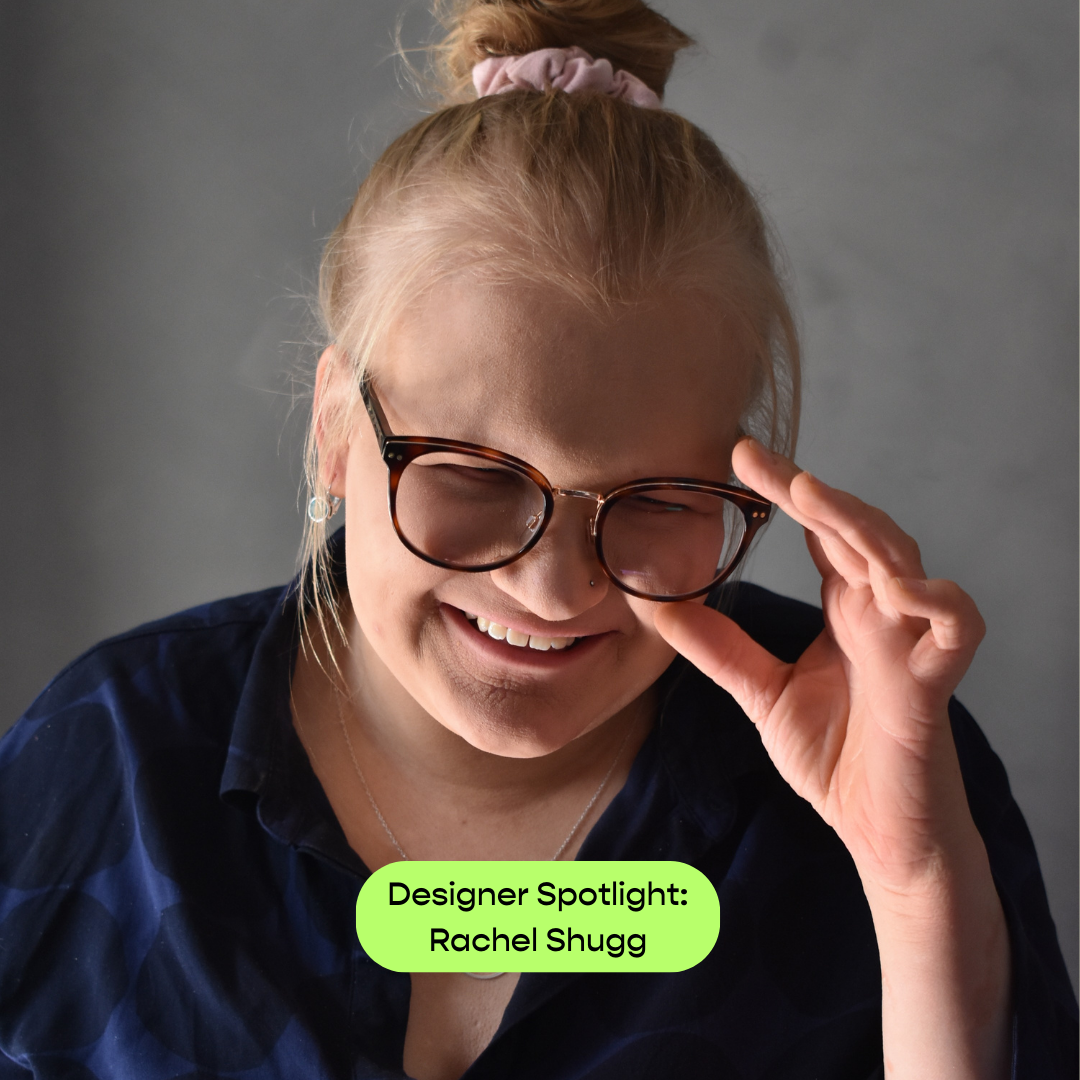Our capsule collection was designed alongside Rachel Shugg. Rachel is a junior designer who originally approached us looking for an internship. Rach worked alongside us to create our bespoke pieces for our runway at Australian Fashion Week in 2022 and has designed our capsule collection that debuted at PayPal’s Melbourne Fashion Festival in March.
We have been so lucky to have Rach collaborating with us on these collections. Rach was happy to have a chat with us and we hope you enjoy the below.
What was your journey into fashion design? Were you interested in fashion design from a young age?
I have always loved fashion! From the way it can make you feel, to the variety of it, to the art of creating something from scratch. There was a time when I really struggled to find clothing that suited my disabled body and that I liked and wanted to wear. I think this is when I first started getting into fashion as I realised that I could start to design what I wanted to wear. When I was younger, I used to have a colouring-in book of mannequins that I could draw clothes and designs on. From there I started to take it a little more seriously and took fashion at school and later studied it at university.
It's not just fashion that I love. I love clothes. I think that they can have transformative power. They literally shape who you are. It can be armour to make you stronger, or the cardigan to wrap around you when you need comfort, the tracksuit that you slip into after work, it’s the gown that made you empowered. But it can also be the dress that just doesn’t look good, it’s the fully stocked wardrobe when you just don’t have anything to wear out tonight, it’s the jeans that cut into you. I’m interested in the relationship between the body and the garment and the connection it has with your emotions. It sounds a bit cliché, but clothes are poetic to me. I also love the creative process of making a garment. We sketch, draft, drape, trace and cut a map of the human body and then flatten it down into 2D shapes and then stitch in curves, darts, pleats and elastic, drawing these pieces together to create a puzzle of clothing that cloaks itself around the human body.
Who are your fashion inspirations / who do you admire in the industry?
There are so many! I can always find inspiration and craft from creative giants such as Margiela’s masterful way to subvert standards. Similarly, Rei Kawakubo of Comme des Garçons ability to challenge conventional notions of fashion. Viktor and Rolf always encourage me to challenge the boundaries and examine the purpose of the project deeper. Iris Van Herpan’s transformative works of art and technology are like wearable poetry to me. I can always find motivation in Alexander McQueen’s bold and sometimes daring pieces that marry subversion and tradition to make art. I often dive into the archives of these designers to see how they imagined and reimagined archetypical pieces. Stella McCartney is another one of my favourite designers, her push towards sustainability and appreciation for the environment is something I think we should all strive towards.
Disability and inclusion advocate Sinead Burke was one of the first people who introduced me to accessible design within the fashion industry. Her love and appreciation of fashion and art with her continual demand and push to make the fashion industry a more inclusive space has been a driving inspiration to me.
What do you wish people knew about adaptive or inclusive fashion?
At the moment, while accessible fashion is on the rise, one of its barriers it is still extremely limited in the diversity of styles and function variety. There are still many misconceptions about what accessible design really means. It goes beyond the surface of putting someone who is disabled in clothing. It takes time, research and a lot of collaboration to create a universally suitable garment.
An understanding of the lived experience and embodiment of disability in both the physical and social environment is necessary for the fashion industry to embrace disabled communities and propose alternative methods of design.
A key challenge in designing for disability is the range of disabilities and the extent to which they affect the person, be they limb impairment or amputation, neurological barriers, or intellectual or sensory. This paired with the lack of adaptive and inclusive clothing on the market can leave the wearer with a limited selection of clothing to choose from.
What do you think the future of fashion is?
I think that the future of fashion is an accessible and sustainable one. As we strive to become more inclusive and sustainable, I hope that a collective mind shift will follow that encourages us to think about how we approach and consider marginalised and disabled bodies, which can push us towards a more inclusive future.
Whilst I am the first to declare my love for fashion, it comes with a high cost to our social and environmental world. It is important then to strive for a better, more inclusive. ethical and sustainable world. A change to the industry has to happen in order to achieve this. I think it begins by slowing down. Considering the principles of slow design encourages the fashion industry to stop supporting the fast fashion industry and slow the demand for instant gratification clothing. I think then you have space and time to embrace a Universal Design approach that considers the design needs of a large group of people. An empathy-driven approach that can consider the needs and wants of a large number of people, highlighting the importance of inclusivity and disability within the fashion industry and the value of embodied experience.
Disrupting a system that values the currency of youth and trends has the potential to create ripples of change across our society. I hope that in contributing to this area of disability rights and fashion, I de-stigmatise and normalise disabled bodies and the lived experiences of people with disabilities, and further innovate accessible design. Whilst it might sound idealistic, inclusive design isn’t just a niche trend that will die off in a couple of months, it is here to stay.
You will now have had your designs at Australian Fashion Week and Melbourne Fashion Festival, how do you feel about that?
Very surreal. I have to keep pinching myself that an amazing brand and team such as JAM took me on and gave me this incredible opportunity. It is such an amazing feeling to see people enjoying the garments and feeling empowered through clothes that they can wear and want to wear.
What does fashion mean to you as a person with disability?
As a lover of all things fashion, fashion to me is so much more than just self-expression - it is a chance to be heard, to make a statement, to hold me up, to create art and make the world I live in accessible to me. I believe strongly that fashion can and must exist in harmony with the body and the environment. It is a reflection of our social, political and environmental landscape, and had the power to influence it. It can be easy to dismiss it as superficial but it can be an incredible instrument for change.
The industry can also be very unwelcoming and damaging in many aspects. The way fashion interacts with my body is a reflection of the society around me. I feel a privilege and responsibility to be able to contribute to it in a meaningful way. As a person with multiple disabilities, fashion is a tool to instrument changes on an accessible day-to-day level that can further the understanding of what it is to be inclusive.
What was your experience with shopping like growing up? Do you feel like this has influenced your work as a designer?
My physical disability was progressive when I was younger, so my experiences with shopping were often changing. My first experience was trying to find black school shoes that would fit over my orthotics and AFOs. It was always a struggle to find pants that would fit over my leg splints and wouldn’t snag on the Velcro and bulky plastic. I had full-length plaster casts and splits when I was about 12, and we (my parents and i) couldn’t find anything that would fit me properly or that I actually wanted to wear. Often when I was shopping in my chair I would be hard-pressed to find an accessible changing room or one that wasn’t filled with excess retail stock. I would have to buy the garment, try it on in an accessible bathroom (typically on another floor of the shopping centre) and then return it if it didn’t fit, which was the case most of the time. Fashion growing up never seemed to match this image I had of it in my head. Today what I wear changes every day from my mood to how I feel physically and what mobility aid I’m using.
My early fashion education taught me to view the body as a very static immovable being that fits into a standard clothing size. As I began to learn more about couture artistry and the nuances of the human body and how it moves I started to realise that the way I need to approach designing for my body and other disabled bodies is really different. I started to consider all of the things I find harder to wear, clothing that doesn’t move with you, that rubs against you, and that triggers an unwanted emotional response are all incredibly important when designing for people. All of those things that make our bodies unique and different are really important in the design process. I try and keep all of this in mind when I design. I aim to adopt an empathetic approach to the body in my design process that can exist alongside style and function.



Comments
WOW what an inspiring woman,keep up your great work. Have a great day.Kerrie.